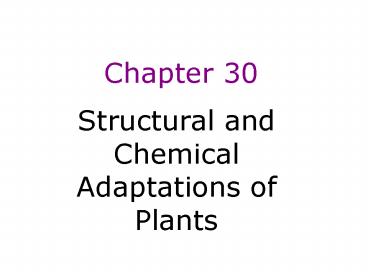Chapter 30 Structural and Chemical Adaptations of Plants - PowerPoint PPT Presentation
1 / 19
Title:
Chapter 30 Structural and Chemical Adaptations of Plants
Description:
What physical constraints shaped the evolution of vascular plants? ... Mechanical defense: waxy cuticle, spines, hairy leaves, sticky leaves, silicates ... – PowerPoint PPT presentation
Number of Views:200
Avg rating:3.0/5.0
Title: Chapter 30 Structural and Chemical Adaptations of Plants
1
Chapter 30
Structural and Chemical Adaptations of Plants
2
Key Questions
- What physical constraints shaped the evolution of
vascular plants? - What kinds of tissues make up vascular plants?
- How do plants defend themselves against
herbivores?
3
Physical Constraints
- Photosynthetic
- Need a constant supply of carbon dioxide and
water - To survive on land plants evolved roots, stems,
leaves and a vascular system
4
Shoots and Roots
- Shoot above ground have stems and leaves
- Roots below ground
- Vascular system travels between shoot and root
- Xylem transports water and minerals
- Phloem transports the sugars
5
Shoot and Root
6
Flowering Plant Tissues
- Meristem regions of actively dividing
undifferentiated cells - Apical meristems tips of roots and shoots where
vertical growth occurs - Lateral meristems makes secondary growth,
development of wood, add to the thickness of the
shoot - Dermal tissue system equivalent of skin,
epidermis and cuticle, must control water loss - Stomata tiny holes on leaves, allow carbon
dioxide in and oxygen and water out. - Flowering plants are made of dermal, ground, and
vascular tissues. Cuticle covers the outside,
ground lies between the epidermal and vascular
tissue, and vascular tissue carries water and
sugar throughout the plant.
7
Epidermal Cells With Stomata
The leaves of plants must be water-tight so that
water is not lost, but for transpiration and
photosynthesis to occur, carbon dioxide must get
into leaf cells and oxygen and water must escape
the leaf. Stomata form closeable holes in the
leaf surface. The guard cells on either side of
the stomate allow the hole to close when too much
water is lost.
8
Parenchyma
- Cell of ground tissue
- Delicate, living cells with large vacuoles
- Only a thin primary cell wall
9
Collenchyma
- Cell of ground tissue
- Uneven, thickened primary cell wall
- Form bands or sheets just inside epidermis
- Mechanical support
10
Sclerenchyma
- Cell of ground tissue
- Stiff cell walls
- Mechanical support
- Fully functional when dead
11
Primary and Secondary Cell Walls
All cells have primary cell walls which are
composed of cellulose, hemicellulose and pectin.
The secondary cell wall deposits on the inner
face of the primary cell wall and is made of
cellulose and lignin.
12
How Plants Respond to Gravity
- Rigid cell wall surrounds plasma membrane of
each cell - Primary cell wall
- Secondary cell wall
- Large central vacuole
- Turgor pressure water pressure inside the cell
keeps cell membrane pressed tightly against the
inside of the cell wall as long the plant has
enough water.
13
Thinking About the Possibilities
- Some plants spread out across the ground and do
not grow in height. Others use a lot of energy
growing taller and taller. What are the
advantages of growing tall?
14
Xylem and Phloem Cells
15
Xylem
- Tracheids long, thin spindle-shaped cells
connected to other cells by pits dead at
maturity slow seeping of water - Vessel elements shorter and wider than
tracheids perforated end walls dead at
maturity rapid passage of water
16
Phloem
- Sieve tubes and elements
- Lack most organelles, elongated shape, sieve
plates on ends carry sap consisting of water,
sugars, proteins and RNA - Companion Cells
- Living cells with primary cell wall, variable
shape, numerous plasmodesmata connect to elements
17
- Monocots
- Single cotyledon
- Parallel veins in leaves
- Vascular bundles scattered in stem and in center
of root - Flower parts in groups of 3
- Small masses of roots
- Grasses, corn, wheat, irises, lilies
- Eudicots/dicots
- Two cotyledons
- Network-like veins
- Vascular bundles in outer area of stem and in
middle of root - Flower parts in groups of 4 or 5
- Single, large taproot
- Oak trees, azaleas, most other flowering plants.
18
Plant Defense
- Mechanical defense waxy cuticle, spines, hairy
leaves, sticky leaves, silicates - Chemical defense terpenes, phenolic compounds,
alkaloids, mustard oil these repel insects
19
Key Concepts
- Rely on underground roots to obtain water,
minerals, and shoots to obtain carbon dioxide and
sunlight - Vascular system consists of xylem and phloem
- Produce secondary compounds that protect plants
against predators or attract pollinators































